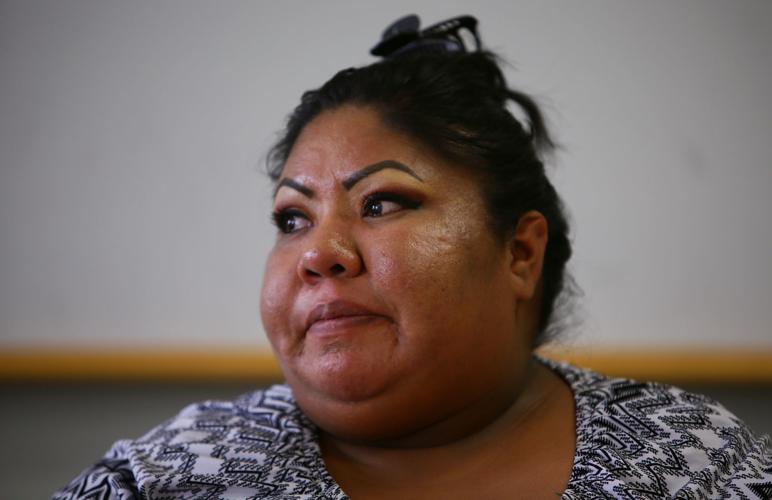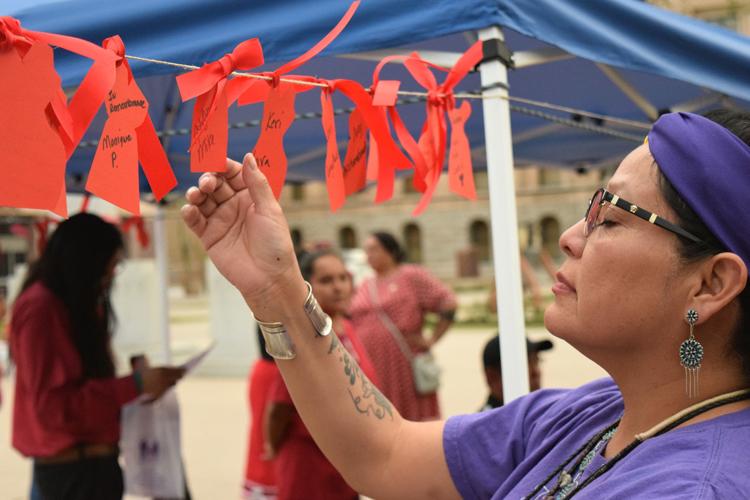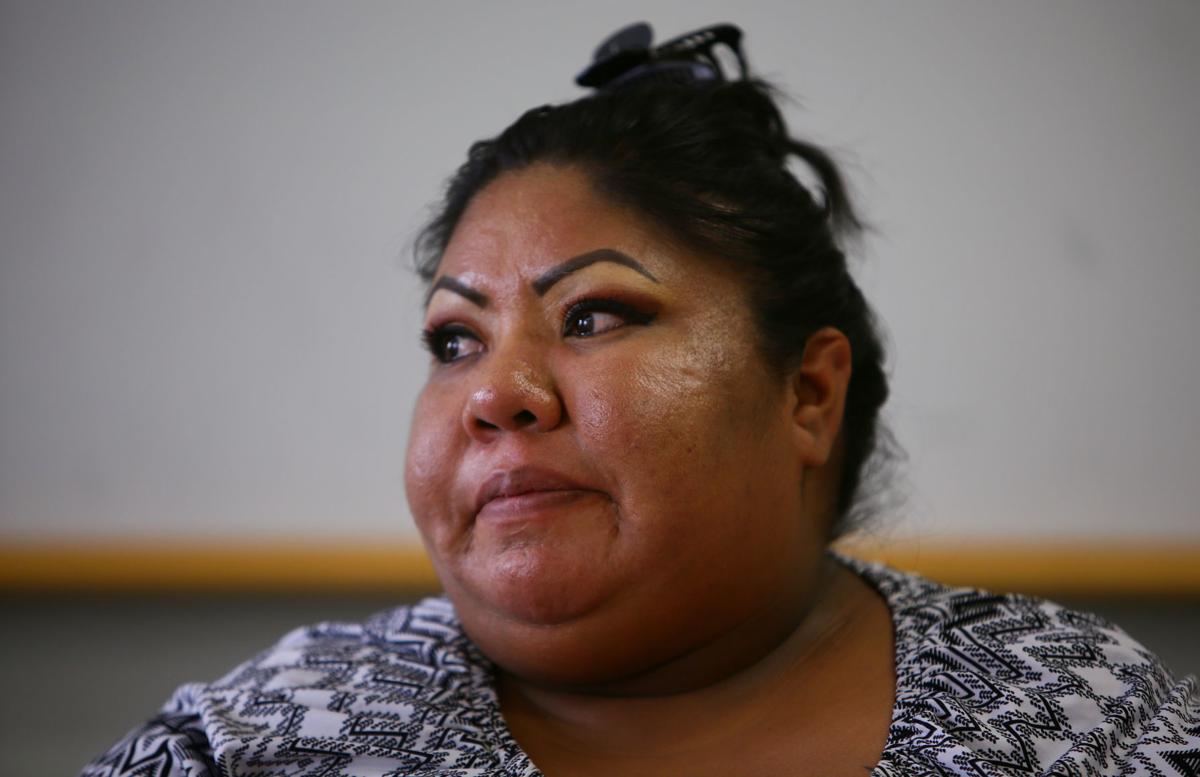Tara Myers’ sister was shot and killed a five-minute walk from their childhood home in Sells.
Myers doesn’t know why her sister, Kim Myers, was in a wash with several others the morning she was killed. She had no gang affiliations, but court documents say the shooting that killed her involved gang members. In the shooting, a truck rolled up and men dressed in red jumped out. After threatening the whole group, one of them pointed a gun at Kim and shot her in the face.
The women, both Tohono O’odham, grew up in an alcoholic family and struggled with alcoholism themselves.
Tragedy struck their family more than once. One brother died in a drug-related incident. Another brother was killed. And their mother died from alcoholism.
When Kim was killed, the 39-year-old mother of four had been trying to get sober. At one point, she was in counseling and parenting classes through Sell’s behavioral-health system.
She had recently enrolled in culinary classes at Pima Community College. She helped organize for her church. She was proud of her culture and her language.
On Tara Myers’ fridge, in a little apartment on Tucson’s south side, is a picture of her sister. Over a decade older than Tara but strikingly similar, she is wearing a pink shirt with shoulder cutouts. Her body turned to the side, she holds her head high and looks straight into the camera.
“As much as she went through,” Tara says, “she knew she was going to be somebody.”
MORE: O’odham woman’s death echoes across generations
Tara wonders if things would have been different for her sister if she had found more support to deal with her trauma and addiction.
She hopes a new state law to study the issue of missing and murdered indigenous women will help bring assistance and justice to others in her community.
“I know that for me, there is help available,” she said, naming some of the resources that have been vital for her in her own journey to getting sober and processing her past.
“I also know that these resources aren’t available to everybody and that there are thousands of missing and murdered indigenous women who are not accounted for and whose families are not getting help.”
Arizona joined states across the country with a law signed by Gov. Doug Ducey on May 14 that aims to reduce and end violence against indigenous women, who are more than twice as likely as other women in the state to be victims of homicide.
The new law, introduced by state Rep. Jennifer Jermaine, D-Chandler, whose family is from the White Earth Nation of Minnesota, will create a study committee to collect data on missing and murdered indigenous women and girls.
“That’s the biggest missing piece — is that the data isn’t there,” Jermaine said. “It’s not that it doesn’t exist. It’s that no one is collecting it.”
Led by the Indigenous Peoples Caucus of the Legislature, the committee will aim to work with local law enforcement and other agencies to establish methods for collecting data on violence against Native women and will propose solutions for creating and enhancing culturally appropriate responses and solutions to violence.

Tara Myers made ribbons to commemorate murder victims at Homicide Survivors. She says a hug at a group meeting was what she needed after being overcome with grief.
Flawed data
Seeing a lack of attention on violence experienced by Native American women who live off reservations, the Urban Indian Health Institute, a division of the Seattle Indian Health Board, released a study last year that collected data on cases of missing and murdered indigenous women in 71 cities across the country.
According to the U.S. Census Bureau, 78 percent of Native Americans lived outside of tribal lands in 2010, the last time the count was done. There is no comprehensive count of how many indigenous women go missing or are victims of homicide, in part because different law enforcement agencies have no uniform method of tracking this data, no interagency tracking and often don’t track data based on both race and gender.
Law enforcement in cities routinely misclassify Native Americans’ ethnicity, which could mean inaccurate statistics concerning violence against the huge swath of indigenous people who live in urban centers.
The institute’s study named Tucson as having the fourth-highest count of missing and murdered indigenous women. Further review of the data by the Arizona Daily Star showed the study had an inaccurate count for Tucson, in part because of confusing data.
Tucson police provided the institute with a list of 27 cases, going back to 1992, involving deceased Native American women. Three cases were listed as homicides, and the remaining 24 had the cause of death listed as unknown. When cross-referenced with medical examiner records, only one of those 24 was a homicide, in which Tucson police assisted in a homicide case in Sierra Vista.
Law enforcement agencies should enter a cause of death in their records after a determination is made by the medical examiner rather than leave the unknown status, says Annita Lucchesi, who is Southern Cheyenne and a researcher on the study. Doing so will help start the process of accurate data collection.
After the study came out, Tucson police reviewed homicide cases with Hispanic female victims and found nine Native American women and girls who had been misclassified.
The Star requested the same data from the Pima County Sheriff’s Department, and it provided a list that included four homicides and four missing-persons cases. But upon an inspection of the individual reports, most didn’t have a female Native American victim.
Inaccuracies happen because of human error, data-entry issues and changing methods of maintaining records, said Amber Halkowitz, a specialist in the records department for the agency.
The Sheriff’s Department doesn’t regularly track data on victims by ethnicity and gender, making it difficult to accurately compile a database.
Identifying someone’s ethnicity is usually either based on family information or appearance, say Jacob Cramer and Sgt. Scott Ellis of the Tucson Police Department’s analysis section.
But getting indigenous people’s ethnicity right is important because Native Americans belong to sovereign nations, with their own governments and laws.
Lucchesi says she understands that if law enforcement asks for someone’s ethnicity, it could be perceived as an incentive for bias, but officers should tell victims’ families they’re asking in order to assist in collecting accurate data on violence against Native people. She says it’s also important that specific tribes are notified if a tribal member is murdered or goes missing.
“We can’t design effective solutions if we don’t have access to the data,” she said.
“I don’t think there’s necessarily one uniform answer that’s going to work for every part of the country and every tribe.”

The Arizona State Capitol dome in Phoenix is illuminated in red in honor of missing and murdered indigenous women and girls on May 5, 2019. T
Native women finding solutions
Historically, there hasn’t been a good relationship between tribes and non-native governments, making tribes reluctant to share data, said state Sen. Victoria Steele, D-Tucson, who is Seneca/Mingo. She introduced a missing and murdered indigenous women bill in the Senate and threw her support behind the House bill when it began gaining steam.
“All we have are some very scary numbers and a lot of anecdotal evidence that’s been going on for many years,” she said.
“And part of the problem is there really has not been news coverage until just recently. Nobody’s really paid attention to this. And so Native peoples end up feeling like their women, their girls’ lives, aren’t valued as highly.”
Even the Violence Against Women Act (VAWA), the 1994 federal law to break down barriers in protecting women from violent crime, largely failed to protect Native women.
A Department of Justice report says 96 percent of Native women who experienced sexual violence in their lifetime had a non-Native perpetrator. Yet until 2013, tribal courts weren’t allowed to prosecute non-Native suspects regardless of whether the victim was Native.
These cases would go to the U.S. Attorney’s Office, which in turn declined to prosecute 46 percent of assault matters and 67 percent of sexual abuse and related matters referred from tribal lands from fiscal year 2005 through 2009, according to a report from the U.S. Government Accountability Office — meaning non-Native perpetrators were often not held accountable for crimes against women on tribal land.
The 2013 reauthorization of VAWA allowed tribes jurisdiction over domestic-violence cases committed against Native Americans on tribal lands. And a provision in the 2019 reauthorization would extend that jurisdiction to include perpetrators of sexual violence and stalking. Although the current authorization of VAWA passed the House in April, it’s been stalled in the Senate since.
Many serious crimes committed on tribal lands fall under a mishmash of federal, state and tribal jurisdictions, regardless of whether they involve a Native American victim or perpetrator.
Lucchesi, with the Urban Indian Health Institute, says sending in federal agencies to assist underfunded tribal law enforcement and governments isn’t working.
“The problem is tribes’ sovereignty isn’t being honored and respected,” she said. “Tribes aren’t able to protect their women.”
Tribes not having jurisdiction over these cases and the lack of interagency coordination can lead to victims falling through the cracks, she said. Part of the answer is building the capacity and sovereignty of tribal government, courts, law enforcement and grassroots organizations.
Leanne Guy has been working to end violence against Native women and girls for more than 20 years. A member of the Diné (Navajo) Tribe and founding executive director of the Southwest Indigenous Women’s Coalition, she says there should also be more funding for tribal coalitions like hers, which advocate for Native people, and more funding to support tribal members who live in urban areas.
Native communities often deal with sexual assault, domestic violence and sex trafficking, along with high poverty rates and substance abuse, she says.
“All of that creates the potential for violence to happen,” she said.
“And then on top of all that, you have the political climate of the world that we currently live in — racism, patriarchy, capitalism, misogyny — all of that also just created the perfect mix of things to have violence against our Native women.”
Members of grassroots organizations say inadequate federal and state funding has mobilized them, filling in where needed.
Valaura Imus-Nahsonhoya, who’s Hopi, founded Honwungsi Consulting Services in Phoenix to provide aid to Native American families of a missing or murdered loved one.
A victims’ advocate with 16 years serving tribes throughout Arizona, Imus-Nahsonhoya helps guide families through the judicial system, starting by connecting them with the agency and detective handling their case. She also connects families to counseling and other basic resources, covering any costs through fundraisers or out-of-pocket.

Pamela Foster’s 11-year-old daughter, Ashlynne Mike, was kidnapped and murdered in 2016 on the Navajo Nation in New Mexico. Foster was instrumental in getting an Amber Alert system for Native children.
Native resilience
Tara Myers was homeless and living in Tucson when she quit drinking. She had lost her two little kids to the state within two weeks of her sister Kim’s death. She didn’t know where to turn for help, just that she needed to find some way to cope with her trauma, stay sober and get her kids back.
“I literally had nothing, just the clothes I was wearing,” she said. “But I had to do something for my kids. It was just knowing that there was a chance I would never see my kids again.”
She went to a Homicide Survivor’s vigil not long after she got sober, which was also shortly after the trial for the man who shot her sister. He was sentenced to three years in prison for involuntary manslaughter.
Nearing the anniversary of her sister’s death, Tara cried after holding tears in for a long time. Lost in her grief, someone at the vigil hugged her until she said she was OK. She never saw who it was.
“At that time, that was all I needed was that hug,” she said. “I can remember that hug right now.”
All the feelings that had been buried under anger and addiction came flooding in. She found herself crying on the bus, while crossing the street, in line at the store.
She started going to support groups and equine therapy with Homicide Survivors. She enrolled in behavioral-health courses with CODAC and did classes for parenting, healthy relationships and substance abuse. She did one-on-one therapy and couples therapy with her boyfriend. And she hitchhiked out to Sells for additional parenting and life-skills classes.
In January, the Primavera Foundation helped her and her boyfriend get into an apartment and, soon after, they both found jobs. And earlier this month, she found out that her kids could come home.
Tara wishes her family on the reservation had the kind of services she does in Tucson. She said there are some behavioral-health services on the Nation, but programs come and go.
“They set up for a month or two,” she said. “They start this program, they get people in, and then the program leaves.”
Edward Manuel, chairman of the Tohono O’odham Nation, says the nation has a victim witness program. The nation also has behavioral-health programs and regional health provider Arizona Complete Health can go to the reservation to provide services, he said.
Manuel also helped start a domestic violence program in the early ’90s, which provides assistance like counseling, safe houses and a hotline for domestic violence victims.
“Just like every other program that we have, it always needs additional assistance, whether funding or technical assistance,” he said.
While advocates with Homicide Survivors do their best to serve rural communities such as Sells and Ajo, it’s often hard for them to make it out there with minimal staff and funding. Unlike victims services through the judicial system, Homicide Survivors offers long-term services. Tara doesn’t know how she would have gotten through without that.
A lack of resources for families in the aftermath of such tragedy is one of the problems Native communities face, says April Ignacio, of the Tohono O’odham tribe and chair of the state Democratic caucus for Native Americans. She says Arizona has been so behind in taking care of vulnerable communities that those communities have begun to advocate for themselves.
“All Indian communities sort of face these same issues,” Ignacio said. “It’s just a matter of somebody connecting the dots.”

Cher Thomas is from the Gila River Indian Community in Komatke Village. Her cousin’s mother was killed by domestic violence in the early-90s. Her homicide affected him in irrevocable ways, an as a man, he deals with chronic homelessness and substance abuse. Thomas says her cousin’s story draws attention to the effect violence against Native women has on men. Thomas testified in support of the MMIWG bill and spent the Day of Awareness for Missing and Murdered Indigenous Women and Girls at an event at the state capitol on May 5. She says her role in the movement is to be as civically engaged as possible and show other tribal members that they too have a voice. “We are not as silenced as we think that we are,” she said. “Nothing should come before the will of the people, and the will of the people is that indigenous women should not be murdered in the streets and their names forgotten.









